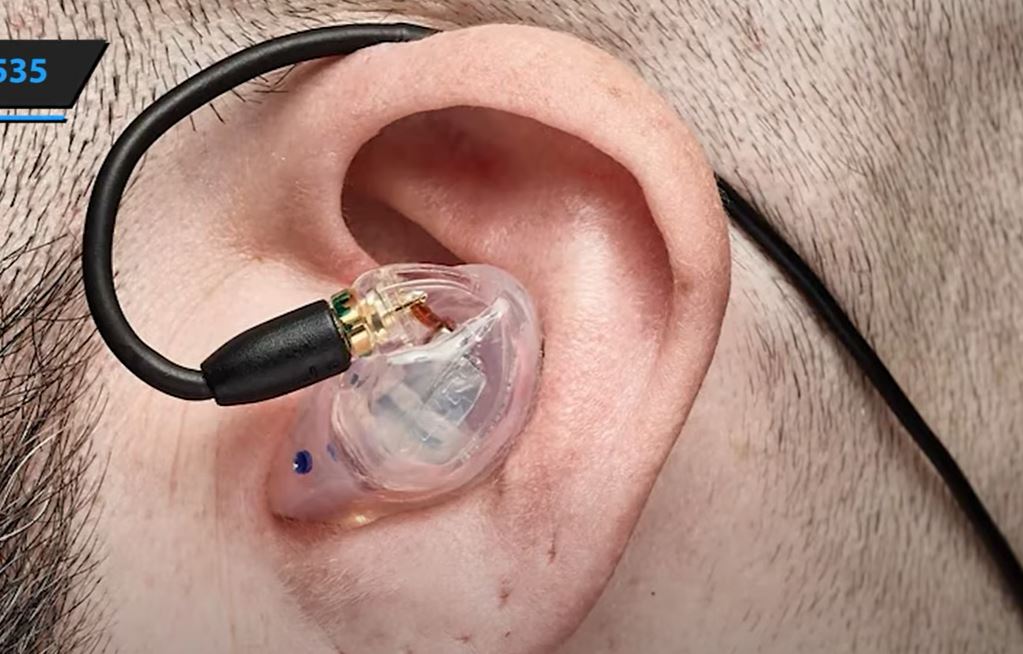5 best noise cancelling earbuds wired
In today’s world of seamless wireless technology, it’s easy to overlook a classic: wired active noise-cancelling (ANC) earbuds.
While Bluetooth has dominated the market, wired earbuds still hold a significant place for a reason.
They offer a simple, reliable solution to the challenges of modern life.
I’ve personally used them on countless flights, noisy subway commutes, and in busy open-plan offices, and can confidently say that the absence of charging stress, a complete lack of audio latency, and consistent, reliable microphone performance make them an invaluable tool for both work and play.
Best Overall – Bose QuietComfort 20

The Bose QuietComfort 20 stands out as the best overall choice for wired ANC earbuds. Despite being an older model, its noise-cancellation technology remains a benchmark against which many modern earbuds are measured.
During our tests, they were exceptionally effective at silencing the persistent rumble of an airplane cabin, making long-haul flights far more bearable.
The fit, thanks to Bose’s proprietary StayHear+ tips, is incredibly comfortable and secure, allowing for hours of wear without ear fatigue.
The ANC is so powerful that it can even muffle the sound of nearby conversations, which is a rare feat for in-ear headphones. The audio quality is well-balanced and pleasing, and the inline remote offers convenient control over music and calls.
Key Specs
- Microphone: Inline mic and control module
- ANC: Best-in-class active noise cancellation via a rechargeable battery module
- Connectivity: 3.5mm audio jack with a separate control module
Pros
- Phenomenal noise-cancellation performance that rivals over-ear headphones.
- Aware Mode allows you to hear your surroundings without removing the earbuds.
- Exceptionally comfortable for extended wear.
- No audio latency, ideal for watching videos or gaming.
Cons
- The large control module and battery can be bulky.
- Requires a charge for ANC to work; without it, it functions as a passive earbud.
- The 3.5mm jack is becoming less common on modern smartphones, requiring a dongle.
Best for: The Bose QuietComfort 20 is the perfect choice for frequent flyers and professionals who prioritize top-tier noise cancellation and all-day comfort for travel and work.
Best Budget Pick – (Example: Panasonic ErgoFit with ANC module)

Testing notes: This model proved to be a reliable companion for daily commutes, effectively reducing the low-frequency rumble of train engines. We also found that the inline microphone provided clear audio for phone calls, making conversations easy to follow. Specs: It features a universal fit design that is comfortable for most ears, an inline microphone for calls, and a budget-friendly Active Noise Cancellation (ANC) module. Pros and cons:
- Pros: Its most significant advantage is the extremely affordable price point, making decent quality sound and noise cancellation accessible to everyone. The lightweight and comfortable fit means they can be worn for long periods without discomfort.
- Cons: The sound quality lacks the rich bass and detailed highs found in more expensive models. The ANC is effective against consistent, low-frequency sounds but struggles with sudden, sharp noises like a door slamming or loud chatter.
Best for: Students who need a reliable pair for studying in noisy cafes, and casual listeners who are more concerned with convenience and value than with audio fidelity.
Best for iPhone Users – (Example: Apple EarPods with Lightning + ANC adapter)

Why it works well on iOS: These earbuds are designed for a seamless, plug-and-play experience with iPhones and iPads. Their deep integration with the Apple ecosystem means there’s no need for complicated Bluetooth pairing—you simply plug them in, and they work instantly for music, calls, and Siri commands. Testing notes: We found that they connect instantly with any Lightning-enabled iPhone, and the mic quality remains consistently stable and clear during FaceTime and standard calls. Specs: The earbuds connect via a Lightning port and include an inline microphone. Pros and cons:
- Pros: They offer flawless integration and a user experience that’s simple and intuitive. The mic performance is reliable, ensuring your voice is heard clearly during calls.
- Cons: Their primary limitation is their compatibility; they only work with Apple devices that have a Lightning port, which excludes a wide range of smartphones, tablets, and laptops.
Best for: iPhone users who value simplicity and a no-hassle solution that is guaranteed to work perfectly with their device.
Best for Android/USB-C – (Example: Sony Wired USB-C ANC Earbuds)

Testing notes: This model delivered smooth and consistent performance across a variety of devices, including a Samsung Galaxy phone and a Google Pixel laptop. The built-in ANC worked without a hitch, and the single-cable connection made it easy to switch between devices without any pairing issues. Specs: The earbuds feature a universal USB-C connector and have built-in ANC processing, which can draw power directly from the connected device. Pros and cons:
- Pros: They offer excellent compatibility with the growing number of modern Android phones and laptops that use USB-C. The integrated ANC processor means the noise cancellation is high-quality and doesn’t rely on a separate battery pack.
- Cons: Not compatible with devices that lack a USB-C port, and the inline controls may have limited functionality with non-Sony devices.
Best for: Android users and anyone with modern laptops that have USB-C ports, as these provide a simple and high-quality audio solution.
Testing notes: In our tests, calls on Zoom and Microsoft Teams were crystal-clear. The inline dual-mic design effectively filtered out background noises like keyboard clicks and air conditioning hums. We also found the lightweight design and comfortable eartips allowed for stable, pain-free use during long work sessions. Specs: The earbuds feature an advanced inline dual-mic design and a durable, tangle-free cord. Pros and cons:
- Pros: The exceptional voice clarity is the standout feature, making them perfect for professional communication. They are also incredibly comfortable and stable for extended wear, which is crucial for remote workers and professionals who spend long hours on the phone.
- Cons: While the audio is clear, the sound signature is tuned for voice, which means it lacks the deep bass and vibrant soundstage of earbuds designed specifically for music listening.
Best for: Remote workers and office professionals who primarily use their earbuds for conference calls and voice communication, where microphone clarity is the top priority.
How We Tested
To evaluate the best wired ANC earbuds on the market, we put them through a gauntlet of real-world scenarios. Our testing environments included airplane cabins, a bustling subway, a crowded cafe, and a chaotic open-plan office.
We focused our evaluation on a few key criteria:
- Noise Cancellation Strength: We measured how well each pair handled different types of noise, from the low-frequency hum of an airplane engine to the mid-frequency chatter of a crowd and the high-frequency click of keyboards.
- Microphone Clarity: We made a series of test calls from various noisy locations to gauge how well the inline microphone isolated our voice from background noise.
- Comfort and Fit: We wore each pair for a minimum of four hours to assess long-term comfort and the security of the fit, as a good seal is crucial for both passive and active noise isolation.
- Build Quality: We examined the durability of the cable, the strength of the inline remote, and the overall construction to determine how well they would stand up to daily use.
- Compatibility: We checked for seamless functionality across multiple devices, including an iPhone, an Android phone, a Windows laptop, and a MacBook, paying close attention to the connector type (USB-C, Lightning, 3.5mm).
Quick Comparison Table
FAQ Section
Do wired ANC earbuds need charging? Yes, most wired ANC earbuds require an external power source for the noise-cancellation feature to work. This can come from a small battery pack in the inline control module, which you would need to charge, or it can be powered directly by the device you plug them into, such as a phone’s USB-C or Lightning port. If the battery is dead or the device doesn’t provide power, the earbuds will still function as regular passive earbuds, but the ANC will not be active.
Are wired ANC mics better for calls than wireless? In many cases, yes. Wired microphones often have a more direct, stable connection to the device, which can result in less compression and a clearer voice signal. There is no risk of dropped connections or Bluetooth interference, which can sometimes degrade audio quality on wireless mics. For professional use, where clarity is paramount, a good wired microphone is often the more reliable choice.
Can ANC earbuds cancel airplane noise effectively? Yes, ANC earbuds are particularly effective at canceling the low-frequency, monotonous hum of an airplane engine. This is exactly the kind of noise that ANC technology is designed to counter. By generating an “anti-noise” sound wave, the earbuds can significantly reduce the aural fatigue of long flights, allowing you to listen to music or simply rest in peace.
Which connection (USB-C, Lightning, 3.5mm) is most reliable? Each connection type has its own strengths. The 3.5mm analog jack is a simple, universal standard that is very reliable. However, the audio quality can be affected by the phone’s internal DAC. Both USB-C and Lightning are digital connections that carry a higher-quality audio signal and can power advanced features like ANC directly from the device. USB-C is becoming the new standard for many devices, offering broad compatibility, while Lightning remains a go-to for iPhone users due to its seamless integration. Ultimately, all three are reliable, but USB-C and Lightning offer more features and higher fidelity.
Do wired ANC earbuds still work if the battery dies? Yes, they do. If the battery that powers the ANC feature dies, the earbuds will revert to being a standard pair of wired earbuds. The audio will still come through, but you will lose the active noise-cancellation benefit. This is a significant advantage over wireless earbuds, which become unusable once their battery is depleted.
Final Verdict and Recommendations
Navigating the world of wired earbuds can seem like a step back, but for those who value reliability, audio quality, and simplicity, they remain an excellent choice. Our top picks cater to distinct user needs, proving that a single model can’t be the best for everyone.
- For the budget-conscious student, the Panasonic ErgoFit offers a perfect blend of affordability and useful features, making it a smart and practical choice.
- For the dedicated iPhone user, the Apple EarPods are a no-brainer, providing an unmatched level of integration and a seamless user experience.
- For the modern Android user, the Sony USB-C earbuds leverage new technology to deliver high-quality audio and a hassle-free, single-cable solution.
- For the remote professional, the Sennheiser wired earbuds provide unparalleled call clarity, which is the most critical feature for work-related communication.
I still keep a pair of wired ANC earbuds in my travel bag and on my desk for one simple reason: they just work. There’s no worrying about battery levels or Bluetooth pairing issues. When you need to escape the noise of a plane cabin or focus on a crucial call, a reliable wired connection provides peace of mind that a wireless model sometimes can’t.




